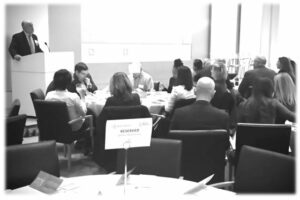Covid-19
COVID-19 upended the way we do business, including in-person events.
 For over two years now, government contractors have wondered when and how federal events will get back to “normal”— shaking hands; networking; and seeing clients, vendors and colleagues face-to-face.
For over two years now, government contractors have wondered when and how federal events will get back to “normal”— shaking hands; networking; and seeing clients, vendors and colleagues face-to-face.
In the past year, attempts to have in-person events have happened in fits and starts. Surges in COVID cases and new variants partnered with government policies regarding event requirements all but pushed us completely back to virtual.
But federal employees are ready to get back to “normal.” Market Connections teamed with Government Marketing University to survey federal employees on their feelings about attending events for the upcoming training Fusing Gov’t & Industry: Event Go/No Go? Half of the respondents said they plan to attend in-person events this year. Of these, a majority, four out of five say they would attend one to three events in person, numbers that match what respondents said in 2019 before the pandemic.
For those focused on the defense market, the news is even better. Respondents across defense stated they were more likely to attend everything from micro- to large-scale events at higher percentages than their federal civilian counterparts. The success of the latest AFCEA West supports this finding. (Editorial recap of event success from fellow federal marketer Sheri Ascencio can be found here.)
Event Value Proposition
To host successful face-to-face events, we must change how we view them. A higher focus on the value proposition in attending is key. What will attendees gain from the event topic/content, speakers, opportunities for product demos and networking? These, along with logistics such as length, location, and requirements should all be considered.
When asked what drives event attendance in a 2019 event webinar survey, eight in ten respondents said the topic is the key driver. Nearly half mentioned networking opportunities and one-third mentioned the keynote speaker. One respondent said they attend events “(to) learn about technology, meet with vendors, meet other IT people, or (for an) interesting topic.” Another respondent from Homeland Security had a similar response: “(To) expand my knowledge and understanding of the topic.”
According to the 2021 Content Marketing Review, even in the midst of COVID, events (both virtual and in person) top the list (81% of federal respondents) as the most effective channel for disseminating content— topping search engines, email, corporate sites and news sites. These numbers further confirm that content is a key factor for the event strategy.
New Factors to Consider: Remote Work and Hybrid Events
In addition, COVID not only changed the way we met, but how and where we work. Today, 86% of federal employees work remotely at least part-time and over half work remotely full-time. This reality begs the question of whether government employees will be willing to attend an in-person event on a day they work from home, or on one of the only days that they come into the office. In short, what would drive them to step away to attend in-person?
Some event organizers are responding to this question by considering a hybrid event format. Yet there is fear that hybrid events will cannibalize the opportunity to meet with customers in person, historically the best way to forge strong relationships.
The bottom line is event organizers want attendees to come in-person. What can you do to drive attendees to make that decision rather watching comfortably from their couch?
To answer this and other questions on event drivers, deterrents, and the future of federal face-to-face events, attend Government Marketing University’s latest training, Fusing Gov’t & Industry: Event Go/No Go? and set your 2022 events up for success.

Aaron Heffron, President, Market Connections
From the Desk of Aaron Heffron, President Market Connections, Inc.
While many of us remember fondly as a kid hearing, “Yes, Virginia, there is a Santa Claus,” we all need to remember, “yes, folks, there will be a federal market after COVID.” Setting aside the debate of when the “after” is a reality, it is not too soon to start thinking about how to position your company to emerge from quarantine stronger and ready for action. You can do this by developing and implementing a marketing plan that accounts for the market realities while it hedges against market uncertainty.
Here are FOUR marketing areas affected by COVID-19 you should reevaluate:
- Events won’t be dead forever, but you’ll need to choose which to attend and sponsor wisely. Our recent COVID related polling of the federal community highlights hesitancy to attend even the smallest of events until the first quarter of 2021. At this point, micro-sized events of under 50 people will be the most likely for federal employees to attend. As you look toward the middle to end of 2021, larger trade shows and conferences may start springing up. Ask event organizers what they are doing to “re-sell” their event. The marketing for the event will be more important than ever as federal employees try to weigh the value of attending. HINT: It’s not only a safety issue.
- Create a webinar strategy that is concise and informative. As remote working and travel restrictions have continued, the prevalence and dependence on webinars has grown. A 45-minute webinar packed with the most recent information, case studies, and forward-looking views is increasingly important as an effective mechanism to educate numerous federal employees at the same time. Rather than scouring online publications and websites for new information, feds are willing to schedule the time to learn both synchronously and asynchronously. Just remember, though, as our content marketing research has shown, minimize the “sell” and maximize the “tell.”
- Adapt your buys to the changes in media usage but hedge your bets. Later this year we will be releasing the 12th edition of the Federal Media and Marketing Study that looks at federal employee preferences for reading, listening and viewing of websites, publications, radio stations and television programming. The survey this year will be measuring habits during the pandemic and we expect to see some drastic changes. The bigger questions will be how long these changes are in place and will longer term behaviors change? Regardless, when the results are public in late October, it will be important to tailor your short-term strategy for media placement and PR to account for these changes. Do not write them off as “temporary” because the tail will be long and may reveal new pathways to the customer.
- Dig deeper to understand what your customer is going through. It will be important to think about how your company will be interactive with your target audience going forward. How affected have your customers and prospects been from the current circumstances? Digging deeper and identifying those specific characteristics of your target audience (including what and who they know) will be necessary, even if you’ve never done it before. Our recent development of federal personas was done with the need for more personal targeting in mind. Individual fears, concerns and values always play a bigger role when there is uncertainty in the market. In 2021 and beyond it will be important to speak to the hearts as well as the minds of the customer as they face fears and concerns that go way past their job responsibilities.
FINAL THOUGHT:
Yes, there will be a federal market in the post-COVID world. What will it exactly look like? Your guess is as good as mine. What we do know now, however, is that with some careful planning and thoughtful actions you can have your organization positioned better than your competitors as new opportunities arise.
But There Is Still Work to Be Done
Over the past 5+ years, Market Connections has surveyed and interviewed thousands of federal employees about agency challenges and needs that could be addressed through IT modernization. It is heartening to see that all the technology and work performed by federal IT contractors over the past half-decade has paid off at a critical time during which the need for federal telework has escalated.
This was further confirmed in a recent article from WorkScoop, which highlighted key insights into how federal agencies were prepared for and responded to necessary telework activity during COVID-19. Thanks to recent IT modernization efforts, many agencies had the technology in place to handle telework requirements. Investments in agency technology, such as the adoption of cloud services and collaboration tools, led to federal agencies being much more prepared for the 2020 health crisis. And while most agencies had the infrastructure in place for an eligible portion of their workforce, most agencies still struggled to transition and keep “business as usual.” Despite all the infrastructure and technology in place, agency culture still lagged in many places.
A New Normal

A Market Connections PulsePoll™ of federal IT decision-makers’ response to COVID-19 found that half of respondents were not (or very rarely) teleworking prior to the pandemic, compared to 90 percent who are currently teleworking at least part-time.
Agencies had to work to prepare staff for the new normal brought on by the need to telework. This included helping staff become familiar with technical aspects of telework (including video conferencing platforms and evolving security requirements) along with the human aspects of telework such as managing remote employees and ensuring comfort levels for employees working from home.
“It took an event of forced acceptance to get comfortable,” Federal CIO, Suzette Kent said (according to the article). She also stated, “Now that somebody’s [teleworked], and they’ve done it every day for 30 days, it’s not scary anymore. This crisis has shown people that we can successfully work differently.”
What Does This Mean for the Future?
The mission is NOT accomplished for the federal IT contractor supporting IT modernization efforts. The basic building blocks are in place, but the key question will be what are agency needs come 2021? As agencies slowly and cautiously reopen to traditional work environments, to what extent will current habits begin to change the future norms? While forcing their employees to keep business as usual during and forcing them to quickly adapt, will this open the door for new telework policies across the board?
According to our ongoing poll, three-quarters of respondents envision working at least part-time in the future. However, many acknowledged that the current situation forced the hand of many supervisors and managers that were hesitant. It will be important to keep an ear to the ground later this year to see which way things go.
Finally, according to the article, Kent says while she hopes to continue to knock out some of the bad things in this situation as quickly as possible, “We’ll also take some of the learnings, the resiliency and the open eyes to what can be done in a digital and virtual environment and save those and use them as a spring for the future.”
Learn more:
- Download the report: How Has COVID-19 Affected Your Federal Customer?
- Read the full WorkScoop article.
